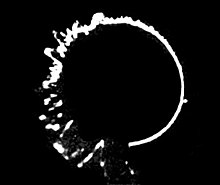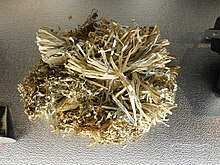Chaff (radar illusion)
As chaff ( English chaff , Window ), Confetti referred to dummy devices , which radars can be disturbed. They were developed during the Second World War .
Name story
The name Düppel is a military proper name that arose from the fact that this agent was tested by the German Air Force near Berlin-Düppel . The opponents of the Second World War had developed Düppel around the same time. In the British Royal Air Force they had the cover name Window , in the USA and in other countries they are called chaff (chaff). Initially, however, none of the warring factions dared to use them in order not to reveal the secret to the enemy. After the results of the Düppel tests had been presented in 1942, Luftwaffe chief Hermann Göring , ordered all reports to be destroyed so that the enemy would not gain knowledge of them. Part of the British military also refused to use it for a long time. It was only after the dangerous rise in bomber losses in 1943 that Prime Minister Winston Churchill ordered it to be used - at a time when Window had already been operational for a year.
functionality

The chaff are made of conductive threads of different lengths. In the past, tinfoil strips were used, today these are mostly metal-coated, wafer-thin synthetic fibers or conductive carbon fibers . They are distributed in the air in different ways. When a radar beam hits the material, the threads act as reflectors and send back some of the radiation . This reflection is most effective when the threads are half as long as the wavelength used by the radar device. This then receives a false echo and can no longer distinguish the real aircraft from the numerous chaff strips. Modern radar systems can only be disturbed to a very limited extent by this effect, among other things because they are able to determine the speed of the object through the Doppler effect . Since the chaff are quickly slowed down in the air, their echoes can be filtered out electronically. Large chaff clouds create radar shadowing (English chaff corridor ) and cannot be penetrated by modern radar devices, so that targets behind such a cloud cannot be detected.
Military operation
There are different methods of using chaff. From an airplane, the material can be thrown off like a curtain, which radar systems can barely penetrate, so that activities can be camouflaged. The first use took place in 1942 by Japan on the Solomon Islands against US radar systems. This venture was unsuccessful, however, probably because too few of the patrols were dropped. Japan struggled to produce these in large quantities. First known use was in the night of July 25, 1943 during Operation Gomorrah -called heavy air raid on Hamburg in the British bombers 40 tons Window threw off, which was approximately 92 million tinfoil. These strips flooded the German radar screens with false radar echoes, as a result of which the Würzburg-Riese radar devices for the fire control of the flak and also the control of the flak headlights completely failed. With twelve planes shot down, the British attackers only lost three percent of their aircraft, otherwise it was often more than ten percent. The Americans used the chaff for the first time on December 20, 1943 in an attack on Bremen .
Since it was quickly found out that such a tinfoil cloud, unlike the attacking bombers, was not moving, just a few months later radar devices in the form of the Würzlaus method were available as an effective antidote that could measure the Doppler effect . Through further measures, such as switching to other radar wavelengths, Window had almost completely lost its effectiveness in a very short time.

A defensive possibility of the chaff use consists in firing individual smaller chaff clouds with rockets or other projectiles in the event of an attack by missiles or aircraft in order to direct the attack on these false targets. During the Cold War era , large American bombers had radar receivers that could measure the wavelength of the enemy radar systems, as well as chaff cutting machines that cut chaff of the appropriate length from rolled up tinfoil strips. Smaller, more advanced devices are still in use in various combat aircraft. Together with flares , chaffs are still an important part of the defensive protective measures of modern combat aircraft.
Different - so z. B. on July 19, 2005 - false images occurred in the weather radar observation over the North Sea. Rain shadows were observed over periods of up to ten hours even though there was no cloud cover. It is partly assumed that these phenomena can be traced back to military experiments with chaff over the North Sea. After further scientific research, this thesis seems to be confirmed with great probability. Such phenomena can be observed in particular in the Temporary Restricted Airspace over the Palatinate Forest and northeastern Saarland ("TRA Lauter"), which is used by the US Army as a military training area. According to its origin, Düppel can usually be seen first as a point-like echo one to two kilometers above the ground. The particles move with the wind at the appropriate height, spread out and sink to the ground.
Meteorological use
In addition to radar deception, chaffs are used in research on the earth's atmosphere to study winds in the upper atmosphere. For this purpose, they are brought into the appropriate layers with the help of sounding rockets and their trajectories are tracked with radar. In this way, highly atmospheric air currents can be measured.
Remarks
- ↑ A radar animation of the Düppel decline on August 1, 2000 over the Palatinate Forest is archived online ( memento from June 9, 2010 in the Internet Archive )
Individual evidence
- ↑ Brevity Code
- ↑ Brian Johnson: Top Secret. Science and technology in World War II. Wiener Verlag, page 122.
- ↑ Gaspare Galati: 100 Years of Radar , Springer Science + Business Media , 2015, ISBN 978-3-319-00584-3 , p. 110 [1]
- ↑ Brian Johnson: Top Secret. Science and technology in World War II. Wiener Verlag, page 122.
- ↑ Development of radio measurement technology on geschichtsspuren.de by Markus Scholz, June 14, 2005
- ^ Charles W. McArthur: Operations Analysis in the US Army Eighth Air Force in World War II , American Mathematical Society , 1990 ISBN 978-0-8218-0158-1 , p. 254 [2]
- ↑ Cajus Bekker: Eyes through night and fog. The radar story. Heyne Verlag, 1988, ISBN 978-3-453-00583-9 .
- ↑ Markus Becker: Radar images: Mystery of the ghost cloud solved. In: Spiegel Online . October 31, 2006, accessed December 14, 2014 .
- ↑ Mysterious Ghost Clouds ( Memento from November 30, 2007 in the Internet Archive ), article on wdr.de, via archive.org
- ^ Statement by the German Meteorological Society on unusual atmospheric radar images ("ghost clouds") ( Memento from September 27, 2007 in the Internet Archive ). On dmg-ev.de (PDF file; 10 kB)
- ↑ Bernd Konantz: Enigmatic Precipitation Front over Switzerland ( Memento from October 7, 2014 in the Internet Archive ). On February 8, 2008 at meteoschweiz.admin.ch
- ↑ Kees Floor: Rare Radarbeelden ( Memento from May 22, 2015 in the Internet Archive ). On keesfloor.nl (Flemish)




